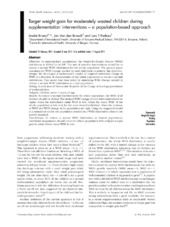Target weight gain for moderately wasted children during supplementation interventions – a population-based approach
Peer reviewed, Journal article
Published version
Permanent lenke
https://hdl.handle.net/1956/6237Utgivelsesdato
2011-12Metadata
Vis full innførselSamlinger
Originalversjon
https://doi.org/10.1017/s1368980011001777Sammendrag
Objective: In malnourished populations, the weight-for-height Z-score (WHZ) distribution is shifted to the left. The aim of nutrition interventions should be to restore a normal WHZ distribution for the whole population. The present paper examines the WHZ change needed by each individual to achieve this objective. Design: We developed a mathematical model of required individual change in WHZ as a function of characteristics of the initial population to restore a normal distribution. This model was then tested by simulating WHZ change needed to restore a normal WHZ distribution in a test population. Setting: A rural area of Democratic Republic of the Congo with a high prevalence of undernutrition. Subjects: Children under 5 years of age. Results: To restore a normal distribution for the whole population, the WHZ of all children should be shifted. The desired WHZ change of each individual should be higher when the individual’s initial WHZ is low, when the mean WHZ of the whole population is low and, for the most wasted individual, when the variance of WHZ and WHZ change in the population are high. Using the suggested model in a simulation on the test population resulted in a WHZ distribution close to the growth standard. Conclusions: To restore a normal WHZ distribution in wasted populations, nutritional programmes should cover the whole population with a higher weight gain in areas where mean WHZ is low.
